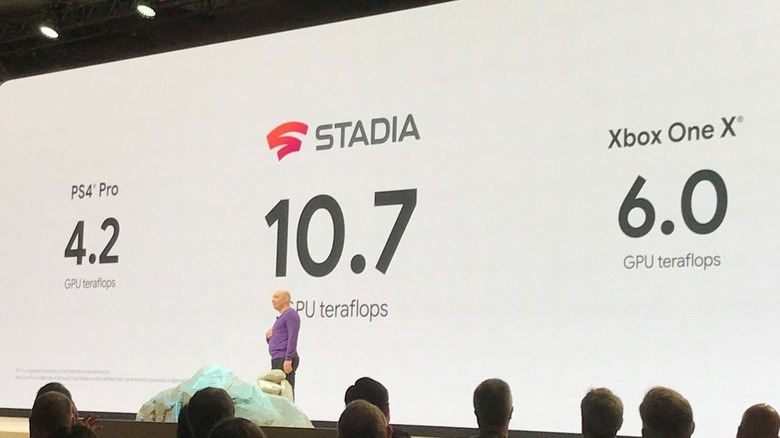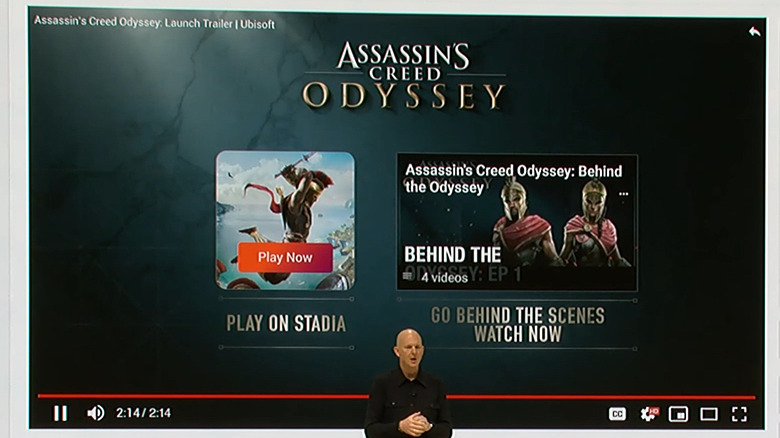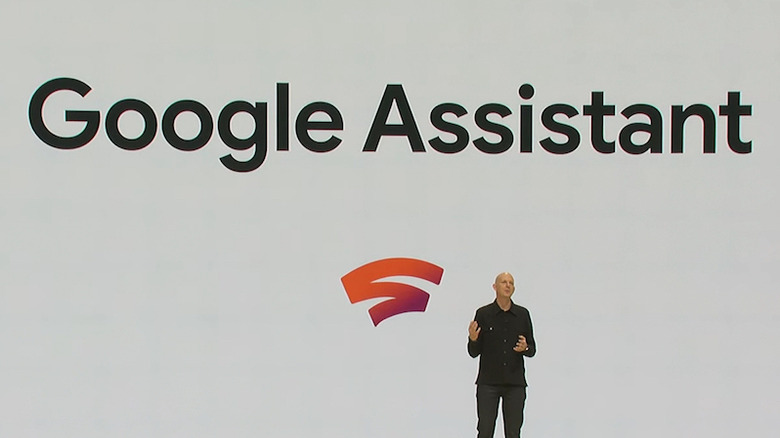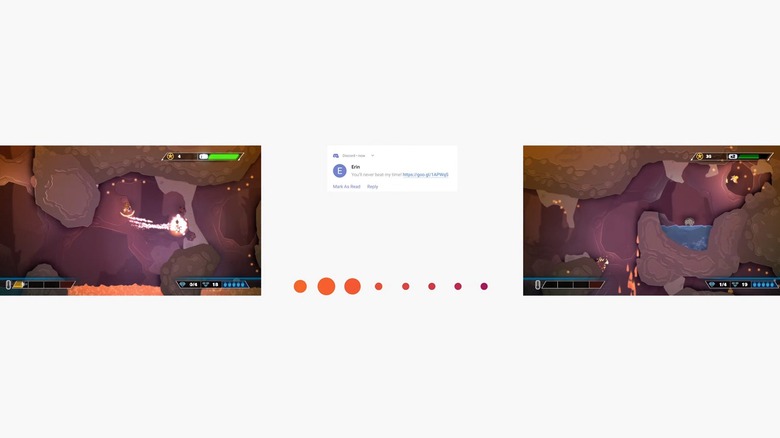Everything You Need To Know About Google's Gaming Platform Stadia
Well before the official announcement of Google's Stadia, there had been signs that Google was planning on entering the video game industry in a big way. Google had in fact been working on a project called Yeti since at least 2016, which was predicated on the idea of utilizing cloud storage, rather than limiting their ideal gaming platform to a traditional console set-up. For one reason or another, however, "Yeti" kept getting pushed back. Until now, Google's biggest forays into gaming were the release of their Nexus Player devices, which more or less did the same job as an Apple TV, enabling streaming video content and a somewhat lower-quality gaming experience through app purchases. The games on the Nexus were essentially glorified mobile games, with Google themselves not making much of a splash in the gaming industry.
That is all set to change, as Google has officially unveiled Stadia, their first company-owned video game platform. Though Stadia spent a few months in beta testing (under the codename "Project Stream"), this was the system's big reveal to the world at large. The major headline where Stadia is concerned is that there is no console required. However, there's still quite a bit more information to be gleaned from Google's keynote address at the 2019 Game Developers Conference. With that in mind, let's embrace the hype, take a dive into Google's big livestream announcement, and discuss what we know so far about the new and exciting world of Stadia.
This thing is POWERFUL
Partnering with AMD, Google has made custom dedicated servers for Stadia, capable of 10.7 terraflops of performance power. As Phil Harrison was more than happy to point out in the livestream (almost immediately), this more than doubles the performance of the PS4 Pro (4.2 GPU terraflops) and even surpasses the mighty Xbox One X, which manages 6.0 terraflops.
As The Verge notes, "That comparison conveniently omits that today's top PC gaming graphics cards can easily top 10.7 teraflops, but it's far closer to a high-end PC than consoles generally come."
This power behind Stadia will allow gamers to stream in 4K resolution and 60fps, with a promised upgrade to 8K/120fps sometime down the line. The point is, thanks to the cloud-based nature of the Stadia, all of this tech isn't being confined to one small piece of hardware, like it would in a console. This allows gamers the freedom to play high-quality games anywhere with an internet connection, since most of the heavy lifting is being done elsewhere.
Naturally, this will require a decent connection. As pointed out by The Verge, "You'll need a constant connection to Stadia to play games on the go. 5G will certainly help here, but only partially and not anytime soon." Hopefully this will be sorted out down the road, because the sheer power Stadia is packing could revolutionize mobile gaming.
You can switch between devices on the fly
Maybe the coolest moment from the Stadia lifestream was when viewers got to see the sheer scope of Stadia's compatibility with different devices. "A key benefit of our platform is that a single creative vision and a single code base can now be enjoyed instantly, across any screen," Phil Harrison explains. "There is no console that limits ... where gamers can play."
This statement was followed by a highly impressive demonstration wherein Assassin's Creed: Odyssey was shown operating from a rather basic laptop. After playing for a few seconds, the action was paused and picked back up on a phone, right from that same moment of play. The process was then repeated on a desktop computer, then finally a tablet, showing the full range of Stadia's reach.
What's most impressive about this is that there is no loss in resolution between devices. Since Google's servers are running the games, Harrison explains during the demo, the game will function properly and look just as the developers intended, "Regardless of the hardware that you're using."
You can play a new game right from YouTube
Another notable moment from the Stadia keynote was when Phil Harrison demonstrated a new way for players to access their games, via YouTube of all places. By clicking a "Play Now" link at the end of a trailer or ad, gamers can boot their new game up almost immediately.
"Performance-wise, you click on a link and the game starts in less than five seconds," said Phil Harrison. "No download, no patch, no install, no updates, and in many cases, no hardware required."
This is not only a great feature for gamers, a notoriously impatient bunch, but it's also a savvy business move on Google's part. By giving Stadia players immediate access to a game that they are already hyped about from a trailer they've just seen, they all but guarantee a quick sale.
As Harrison puts it, Stadia aims "to reduce the friction between getting excited about a game and playing a game." In other words, it's a win-win both for gamers who want their game ASAP and for developers who want to move their product equally as fast.
This YouTube connectivity ties in with another Stadia feature, Crowd Play. Gamers watching a livestream will have the option of clicking and joining a lobby that allows them to access the game in progress. This could not only boost Stadia sales, but will also encourage a whole new level of interaction between gamers and their favorite streamers and creators.
The controller is cool, but you have options
In a hands-on review of the new controller, The Verge reported, "It has a heft and texture similar to recent Xbox One gamepads — specifically the one that released with the Xbox One S redesign — but with the thumbstick layout of Sony's DualShock 4." In reference to the controller's overall quality, they added that "it doesn't seem like Google skimped on this controller." This is good news for a system that is meant to compete with the likes of Nintendo and Sony. Also, the controller has built-in wifi, which will allow it to connect to any Google Chromecast or Chromecast Ultra dongle and will hopefully reduce much of the lag that can come from streaming video games.
Gamers will be able to use any USB or Bluetooth controller of their choosing when using Stadia. However, as Eurogamer points out, if you want to use your own controller and have a TV without smart features, "you'll need to play on a device with an HDMI output like your laptop and connect that to your old TV to avoid using the Stadia/Chromecast combo." This would seem to make the official Stadia controller the ideal way to experience all of Stadia's content, especially when one considers the controller's two most interesting buttons.
Speaking of which ...
There's a Google Assistant button
Picture this: you're playing Resident Evil 2. You're trying to figure out how to find the keycard to the parking garage, but you're just running around in circles and occasionally getting mauled by zombie dogs. All you want to do is find that card, but you've been wandering around for two hours and you're about to chuck your controller through the television screen. Wouldn't it be great if you could just ask, "Where the heck is the keycard in Resident Evil 2?" and your console would tell you?
That's essentially what the Stadia controller does, with a dedicated button that pulls up a Stadia-specific version of Google Assistant. Press the button, ask the question, and Stadia will pull up a YouTube video or search result detailing how to find/solve/kill the obstacle in your character's way.
Phil Harrison of Google explains that this button will allow players to "access the controller's built-in microphone so they can get help from the Assistant for special in-game features integrated by game developers." While these "special in-game features" remain fairly vague, it's still an innovative resource to have at your disposal. If nothing else, we've certainly come a long way from tearing the maps and strategy guides out of our dog-eared copies of Nintendo Power.
State Share may be the next big thing in co-op
One of the more interesting aspects of Stadia is called "State Share." This appears at first to be a feature akin to the PlayStation 4's own Share Button, which allows gamers to record or broadcast their gameplay, but it is in fact much more exciting. At the tap of this button, State Share will allow players to literally bookmark a point in their game to share with other Stadia users. The other users will then be able to click the link generated by State Share and jump right into the game with all of the inventory, health, etc. that the previous player had when they shared their game.
President of Q-Games, Dylan Cuthbert, announced during Google's livestream that his team is in the process of developing a game that utilizes the State Share feature in innovative ways. He says he wants this new feature to "turn my game into an infinite replayable treasure hunt," which intimates that State Share could possibly be made into an actual gameplay mechanic in itself.
The idea of a game that is played by essentially outsourcing certain sections to other players sounds intriguing and could encourage an entirely different form of co-op gameplay. If State Share works as advertised, it has the makings of a whole new trend.
Stadia will develop their own games
While Stadia is intended to be compatible with other company's games, such as the previously mentioned Assassin's Creed franchise, Stadia will not be limited to content from other developers. To ensure this, Google has launched their own studio to make exclusive games for the Stadia platform.
This studio will be called Stadia Games and Entertainment, and it will be run by Jade Raymond, formerly an executive of EA and Ubisoft. Raymond announced that she had joined Google as a Vice President only a week before the Stadia announcement.
"I will not only be bringing first party game studios to reimagine the new generation of games," Raymond said during the announcement livestream, "our team will also be working with external developers to make all of the bleeding edge Google technology you've seen here today available to partner studios big and small."
This is a really exciting prospect, as Stadia Games and Entertainment could be a decent gateway for Google to let some new blood into the gaming industry. There are certainly hungry indie developers who would be grateful for a break in such a large arena.
Also, if Google is looking for original content, maybe they should look into making a full-length game starring that cute dinosaur that pops up in Chrome browsers when the internet is down.
No price point or release date has been set
All technical queries aside, the big question on everyone's minds is, "How much is this thing going to cost?"
Since Stadia users won't be shelling out for any kind of major hardware — unless, of course, they really want to get that proprietary Stadia controller — the most obvious route for Google to go with the Stadia is to set up some kind of subscription program.
Sony's PlayStation Now launched with an overly complicated rental system, which wasn't particularly well received. Because of this backlash, PS Now eventually ditched the rental model and became subscription based. PS Now even began to offer downloadable copies of certain titles. This is a high-profile enough example that it should inform some of Google's decisions moving forward.
As for the release date? Google says that Stadia should be available to consumers sometime in 2019. While that's not super specific, we do know that Google plans to share more details in the summertime. When asked by Kotaku if that meant Google would be bringing more Stadia information to E3 2019, Phil Harrison was very reluctant to give any further details. Still, unless Google plans on pulling a Beyonce and surprise-dropping Stadia, it's pretty safe to assume the release date will be sometime around fall or winter, just in time for budget gamers to have a happy holiday season.









